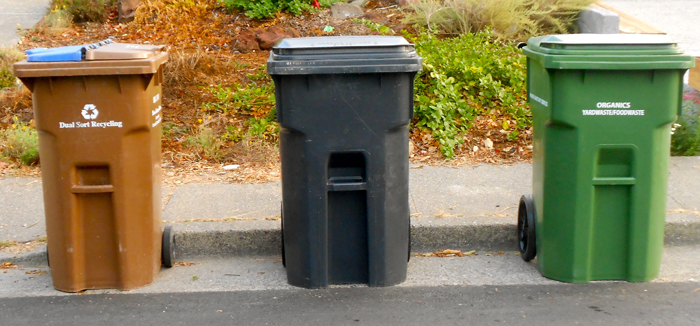LAST WEEK, A new neighbor asked me, “Now that I’m settled in, where do I put my garbage?” Years ago, that question would get a simple answer: “In the garbage can.” But last week, I found it much more difficult to answer.
This was my thinking: newspapers, wine bottles, cans, junk mail and some plastic cups go in the recycling bin; garden trimmings, leaves and dead plants go with our banana peels, steak bones, leftover salad and food soiled paper into the compost bin.
So what — in today’s world — goes in the garbage bin?
“That’s a surprisingly good question,” says Jim Iavarone, an owner of Mill Valley Refuse. Basically, he tells me, garbage is what can’t be recycled or composted. So I was back where I started. Think about it: what in today’s increasing environmentally conscious world can’t be recycled or composted?
“Oh there’s lots of stuff,” Iavarone says, followed by a few seconds of silence. “Styrofoam,” he blurts, “and the popcorn used for packaging.” More silence. Then, together, we come up with other items. “Used Kleenex tissues, dirty rags and clothes no one can wear,” he says. “And grungy old running shoes that I’ve been gardening in,” I add. Also, I offer, plastic bags full of dog poop. We agree that nowadays, not that much qualifies as garbage. And Iavarone adds that more and more, his firm’s garbage pickups are coming back with less and less, actually trucking 1,000 tons less garbage in 2015 than in 2014.
That said, here’s a quick wrap-up of how to get rid of waste in Marin:
• Glass bottles and jars (reasonably clean); all kinds of clean paper; soda and beer cans; catalogs; cardboard and most food cartons — Recycle Bin.
• Lawn and garden trimmings; food scraps, including meat and bones; paper soiled with food; small pieces of lumber; spoiled fruit — Green Bin.
• Out-of-date computers, copy machines and dead batteries; paint and oil; light bulbs with mercury; metal scraps; CDs; old appliances — Marin Household Hazardous Waste Facility.
• Coat hangers; plastic plant containers — Return them to where you got them.
• Plastic newspaper and shopping bags (poop free) — Not recyclable via normal channels, but CVS, Rite Aid and most food markets accept them.
• No longer used, but in good shape books; clothes; appliances; shoes (not grungy); outgrown toys — Goodwill, Salvation Army or other thrift stores.
Hopefully (and ideally), that doesn’t leave much for your garbage bin. And remember, what you do put out as garbage goes to the rapidly filling up Redwood Landfill, where it will sit for ages. Joe Garbarino, of Marin Sanitary Service, says a piece of plastic takes more than 100 years to decompose. “Same for plastic bags,” he adds. As for putting food scraps in the garbage, they will also go to the landfill, where they’ll sit for months and emit the greenhouse gas methane. Far better to put them in with your garden trimmings, where they will be composted and returned to Mother Earth in the form of highly nutritious soil.
OK, so I’m a zealot regarding waste. But so is Zero Waste Marin. The name says it all; its goal is to have zero waste in Marin by the year 2025. And these folks are not hoping-for-the-best do-gooders. The members form a joint powers agency created by the California State Legislature that involves the city managers of every municipality in Marin County, as well as a county representative. Its website, in clear, complete and simple verbiage, answers every possible question you might have regarding recycling, composting and hazardous waste.
If we work together, it is indeed possible to totally eliminate waste (also known as garbage) in Marin County by the year 2025. That’s my point of view. What’s yours?
Email [email protected].
The views and opinions expressed in this article are those of the author and do not necessarily reflect the policy or position of Marin Magazine and its staff.
This article originally appeared in Marin Magazine’s print edition under the headline: “Trash Talk“.


